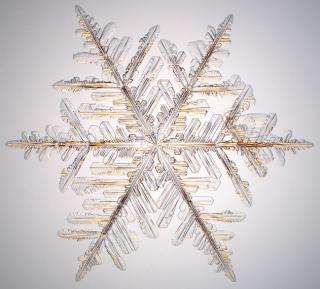Yes, Virginia, some snowflakes can look the same!

Snowflakes are one of the most recognizable and endearing symbols of winter. Their intricate shapes have been the inspiration for Christmas ornaments, jewelry and U.S. postage stamps. They are the subject of song, school projects and even scientific investigation, including a possible impact on global warming.
Jon Nelson, a researcher with Ritsumeikan University in Japan, has studied snowflakes for 15 years, and has some interesting insights into their delicate structures.
Is it true that no two snowflakes are alike?
The old adage that ‘no two snowflakes are alike' may ring true for larger snowflakes, but it might not hold true for smaller, simpler crystals that fall before they've had a chance to fully develop. Regardless, snow crystals have tremendous diversity, partly due to their very high sensitivity to tiny temperature changes as they fall through the clouds.
How do snowflakes form?
A snowflake starts as a dust grain floating in a cloud. Water vapor in the air sticks to the dust grain and the resulting droplet turns directly into ice. And that's where the science kicks in.
First, the tiny ice crystal becomes hexagonal (six-sided). This shape originates from the chemistry of the water molecule, which consists of two hydrogen atoms bonded to an oxygen atom. Because of the angle of the water molecule and its hydrogen-bonding, the water molecules in a snowflake chemically bond to each other to form the six-sided flake. The flake eventually sprouts six tiny branches. Each of these branches grows to form side branches in a direction and shape that are influenced by the clustering of water molecules on the ice crystal surfaces.
Click here to view illustration about how snowflakes are formed.
Why are scientists interested in the study of snowflakes?
The study of snowflakes, which are really ice crystals, has recently become important due to the possible influences that these crystals have on global climate change. Researchers now believe that ice crystals play a crucial role in ozone depletion, possibly by acting as a catalyst to break down ozone. Ice crystals in the atmosphere also play a key role in building up electric charges in clouds and are therefore believed to influence the production of lightning, although the mechanism is unclear.
Jon Nelson has written several research papers on snowflakes, including one in the American Chemical Society journal, "Crystal Growth & Design." That paper, published in 2005, helped explain several previously unanswered phenomena about snowflakes.
Source: American Chemical Society





















